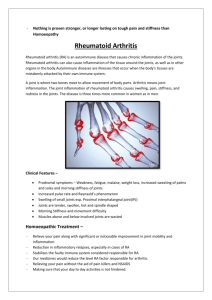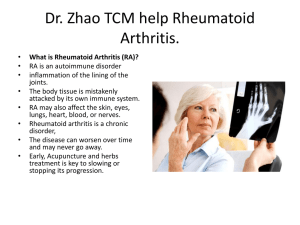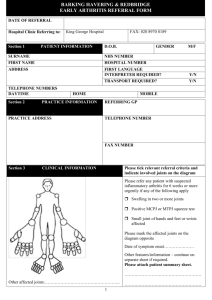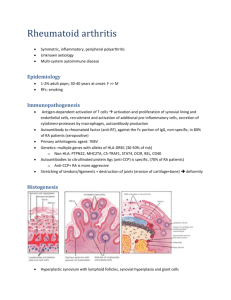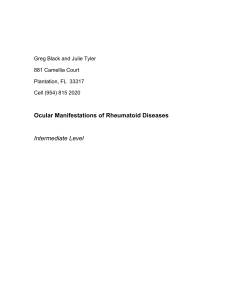RHEUMATOLOGY (1
advertisement
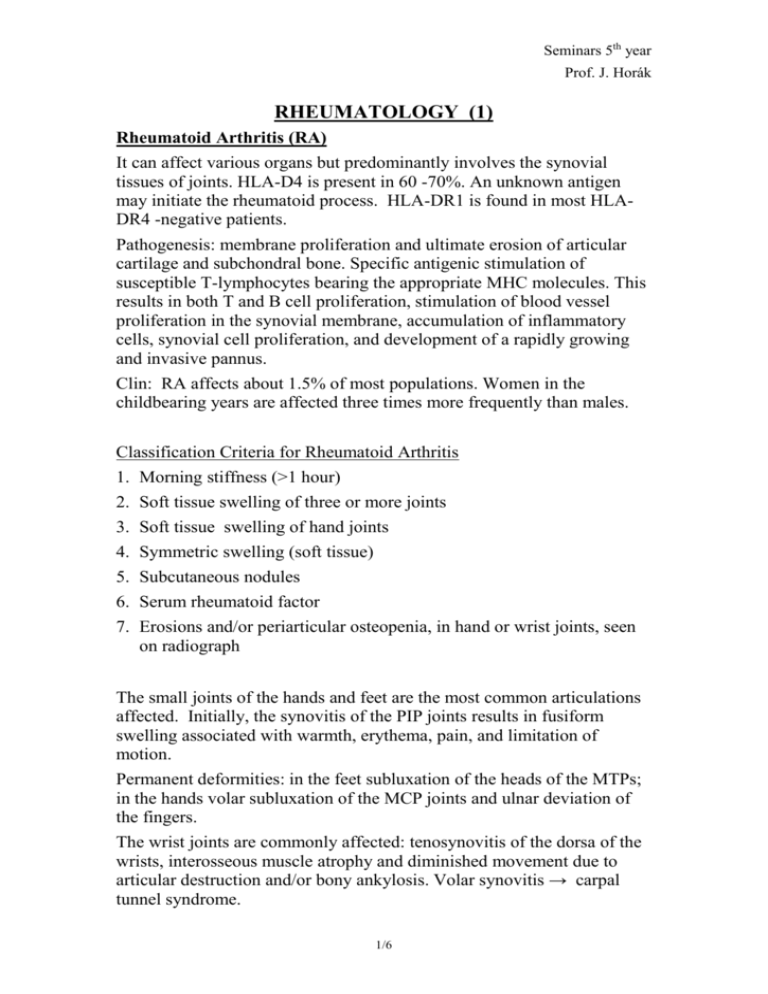
Seminars 5th year Prof. J. Horák RHEUMATOLOGY (1) Rheumatoid Arthritis (RA) It can affect various organs but predominantly involves the synovial tissues of joints. HLA-D4 is present in 60 -70%. An unknown antigen may initiate the rheumatoid process. HLA-DR1 is found in most HLADR4 -negative patients. Pathogenesis: membrane proliferation and ultimate erosion of articular cartilage and subchondral bone. Specific antigenic stimulation of susceptible T-lymphocytes bearing the appropriate MHC molecules. This results in both T and B cell proliferation, stimulation of blood vessel proliferation in the synovial membrane, accumulation of inflammatory cells, synovial cell proliferation, and development of a rapidly growing and invasive pannus. Clin: RA affects about 1.5% of most populations. Women in the childbearing years are affected three times more frequently than males. Classification Criteria for Rheumatoid Arthritis 1. Morning stiffness (>1 hour) 2. Soft tissue swelling of three or more joints 3. Soft tissue swelling of hand joints 4. Symmetric swelling (soft tissue) 5. Subcutaneous nodules 6. Serum rheumatoid factor 7. Erosions and/or periarticular osteopenia, in hand or wrist joints, seen on radiograph The small joints of the hands and feet are the most common articulations affected. Initially, the synovitis of the PIP joints results in fusiform swelling associated with warmth, erythema, pain, and limitation of motion. Permanent deformities: in the feet subluxation of the heads of the MTPs; in the hands volar subluxation of the MCP joints and ulnar deviation of the fingers. The wrist joints are commonly affected: tenosynovitis of the dorsa of the wrists, interosseous muscle atrophy and diminished movement due to articular destruction and/or bony ankylosis. Volar synovitis → carpal tunnel syndrome. 1/6 Seminars 5th year Prof. J. Horák Chronic synovitis of the elbows, shoulders, hips, knees, and/or ankles creates special secondary disorders: - elbow- flexion contracture, loss of supination and pronation - shoulder - limitation of shoulder mobility, dislocation, and chronic pain - knee - hypertrophy of the gastrocnemius-semimembranous bursa (Baker's cyst) of the popliteal fossa. Th: objectives - to relieve pain, reduce inflammation, avoid side effects, preserve or restore function, maintain lifestyle. an ongoing educational program (balanced rest and exercise, physical and occupational therapy) pharmacologic therapy - initiated with NSAIDs (consider side effects) antimalarials (hydroxychloroquine) - ocular toxicity: corneal deposits, macular pigmentation, field defects. gold salts - appear to alter macrophage function. Doses 25 - 50 mg/week i.m. Hematologic, dermatologic, and renal side effects. penicillamine - its effects are slow in expression, significant toxicity on the bone marrow and the kidneys. immunosuppressive agents such as azathioprine, cyclophosphamide, chlorambucil, and methotrexate are effective particularly in severe RA. Esp. methotrexate is very effective and relatively free of toxicity. The oral dose begins at 7.5 mg one time per week. corticosteroids are beneficial in the therapy of acute flare, but their long-term use is not warranted as they neither cure nor alter the natural course of the disease Systemic Lupus Erythematosus (SLE) cause: unknown production of autoantibodies → immunologically mediated tissue injury of several organ systems periods of remissions and acute or chronic relapse common causes of death: renal failure, hemorrhage, infection, pulmonary disease, and vasculitis. The 10-year survival rate ~ 90%. Peak incidence of onset between the ages of 16 and 55 years, more frequent in women. 2/6 Seminars 5th year Prof. J. Horák Etiology and Pathogenesis Immune hyperactivity → production of numerous autoantibodies. Environmental agents such as drugs or ultraviolet light can trigger the disease. Inherited predisposition to SLE is important in some persons. SLE = immune complex disorder; ANA (antinuclear antibodies) and antidsDNA (anti-double stranded DNA) react with antigens in the circulation or the glomerulus → complement fixation → release of chemotactic factors and release of mediators of inflammation from leukocytes → irreversible organ damage. Autoantibodies may be produced against erythrocytes, platelets, and lymphocytes. Typical histologic lesions: „onion-skin lesions“ found in arteries of the spleen, which consist of concentric layers of fibrosis surrounding the vessel; Libman-Sacks verrucous endocarditis – vegetations on heart valves; hematoxylin bodies - globular masses of bluish, dense, homogeneous material seen on hematoxylin and eosin stain; they can be found in all organs, are identical to the inclusion bodies of the LE cells and probably represent the interaction of antibodies to nucleoprotein Subsets of lupus Idiopathic systemic discoid subacute cutaneous (ANA negative) late-onset Drug-induced 90% of patients with discoid LE have disease limited to the skin. Late-onset SLE – presentation after age 50; accounts for approximately 15% of all cases. Neonatal lupus is rare. It appears to be a complication of maternal antibodies transferred through the placenta. Shortly after birth, infants develop typical dicoid lesions with exposure to UV light. However, very few of these infants develop SLE later in life. 3/6 Seminars 5th year Prof. J. Horák Criteria for Classification of SLE criteria definition 1. Malar rash fixed erythema, flat or raised, over the malar eminences, tending to spare the nasolabial folds 2. Discoid rash erythematous raised patches with adherent keratotic scaling and follicular plugging 3. Photosensitivity skin rash as a result of unusual reaction to sunlight 4. Oral ulcers oral or nasopharyngeal ulceration, usually painless 5. Arthritis nonerosive arthritis involving two or more peripheral joints 6. Serositis pleuritis or pericarditis 7. Renal disorder persistent proteinuria > 0.5 g/day or cellular casts 8. Neurologic disorder seizures or psychosis 9. Hematologic hemolytic anemia with reticulocytosis or disorders leukopenia < 4000/mm3 or lymphopenia < 1500/ mm3 or thrombocytopenia < 100000/ mm3 10. Immunologic disorders positive LE cell preparation or anti-DNA antibody or anti-SM antibody or false-positive serologic test for syphilis 11. Antinuclear antibody Drugs with association to SLE: hydralazine, procainamide, chlorpromazine, methyldopa, INH. Renal and CNS involvement is uncommon. The symptoms are usually mild and reversible when the drug is stopped. Clin: periods of exacerbation are followed by remission or inactive disease. Frequent nonspecific symptoms: fatigue, fever, weight loss, arthralgia/myalgia. Arthritis is typically symmetric and involves small joints of hands, wrists, and feet. Deformities similar to rheumatoid arthritis develop 4/6 Seminars 5th year Prof. J. Horák in ~ 10% of patients. Rheumatoid nodules and rheumatoid factors may be present. Raynaud’s phenomenon may result in digital gangrene. Conjunctivitis, episcleritis, or keratoconjunctivitis occur in ~ 20% of patients. Abdominal pain may be a manifestation of serositis, mesenteric arteritis, or pancreatitis or may be secondary to visceral perforation. Acute pneumonitis with or without pulmonary hemorrhage. Renal involvement occurs in ~ 50% of patients: proteinuria, hypertension, hematuria, red blood cell casts are found in active disease. Neuropsychiatric manifestations: depression and psychosis are frequent, impairment of orientation, memory, or cognition. Cardiac manifestation: pericarditis in up to 30% of patients, myocarditis → tachycardia, ST-T wave changes, congestive heart failure, and cardiomegaly. Valvular lesions (the mitral and aortic valve) may occur. Verrucous endocarditis is present at autopsy in nearly all patients with cardiac involvement. Coronary arteritis, thrombosis, or premature atherosclerosis secondary to corticosteroid use may lead to myocardial infarction. Hematologic abnormalities: normochromic normocytic anemia, hemolytic anemia (sometimes Coombs’ positive), leukopenia (usually lymphopenia), and thrombocytopenia. Antibodies to clotting factors: the most common is the lupus anticoagulant (an antiphospholipid antibody) → prolonged APTT. However, it is associated with thrombotic disease and not with bleeding. False-positive tests for syphilis are found in up to 25% of patients. Oral contraceptives containing estrogen derivatives may lead to an exacerbation of SLE. Lab.: high-titer autoantibodies directed against nuclear components (ANA). Anemia, leukopenia, hypergammaglobulinemia, proteinuria, leukocyturia, low serum complement. Th: aim – relieving symptoms, suppressing inflammation, and preventing future pathology. UV light should be avoided in photosensitive patients. Hypertension should be treated aggressively. Estrogen is useful for its benefit regarding coronary artery disease and osteoporosis. Renal biopsy is needed to determine appropriate therapy and prognosis. 5/6 Seminars 5th year Prof. J. Horák Pharmacotherapy: - NSAIDs for arthralgias, mild arthritis, pleurisy, pericarditis, myalgias, and headaches; - corticosteroids to control the inflammatory response to prevent endorgan damage. Doses > 60 mg/day of prednisone may be necessary for brief periods; - antimalarials are used for dermatologic and musculoskeletal manifestations (retinal toxicity); - azathioprine may be useful in moderate renal disease, intractable skin disease or arthritis; - cyclophosphamide (daily oral or monthly pulse i.v.) combined with corticosteroids is commonly used to treat proliferative types of nephritis. ---------- 6/6


